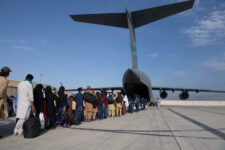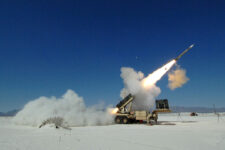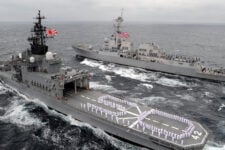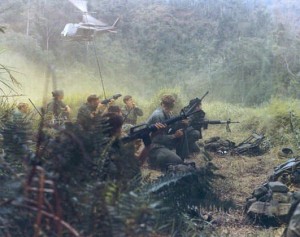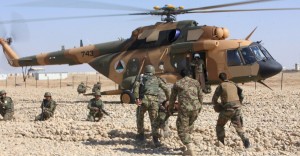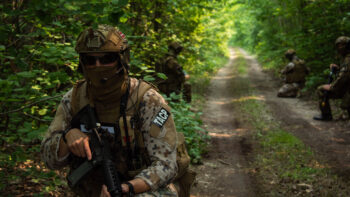When James Kitfield contacted us last year about writing for us, we were pleased because few writers have such a gift for spotting major strategic issues and writing about them first and writing about them with grace and clarity. The following piece in which he asks the seminal question — is America in global retreat and what would it mean — is yet more proof of this. He doesn’t answer the question because it’s not clear yet just what the Obama Doctrine really is. Does it mean America will pursue, capture or kill terrorists but not engage in major military actions beyond our own shores? Does the major drawdown of US forces — especially the Army — forced on the country by a crippled Congress through sequestration mean we will leave a global power vacuum aching to be filled by others, perhaps a rising China? Read on. The Editor.
The juxtaposition of recent images was jarring: Secretary of Defense Chuck Hagel unveiling a defense budget that substantially shrinks the U.S. Army, while insisting that “after Iraq and Afghanistan, we are no longer sizing the military to conduct long and large stability operations.” And then there were the images of masked Russian troops seizing Crimea and threatening to carve apart Ukraine with naked aggression.
President Barack Obama has honed the themes of military restraint and economic renewal into something like a doctrine – a core principle around which national security and foreign affairs policies could be organized and prioritized. Sensing the mood of a war-weary public and Congress, Obama was bent on ending the wars in Iraq and Afghanistan, and appears equally determined to avoid further military entanglements. After a decade of conflict, the Great Recession and an unprecedented rise in national debt, he not unreasonably decided that the United States was in danger of strategic and economic over-extension, the bane of great powers and empires throughout history.
Not A Peaceful World
But the world, as many defense experts note almost every day, is not a peaceful place. The Kremlin’s land-grab in Ukraine, China’s aggressive claim to disputed islands and airspace in Asia, Egypt’s military coup and the Syrian regime’s years-long slaughter of civilians and ethnic cleansing all illustrate the strategic risks inherent in a doctrine of restraint and military retrenchment in a time of profound instability. To Secretary Hagel’s declaration that the U.S. military would no longer be sized for large ground operations, Vladimir Putin has fashioned a refrain reminiscent of his 20th-century countryman Leon Trotsky: “You may not be interested in war, but war is interested in you.”
“There is a perception of U.S. retrenchment around the world, among both allies and potential adversaries, who see that America has a hangover from Iraq and Afghanistan; we’re cutting troops and pulling back forward-deployed forces from Europe, cratering military readiness as a result of the ‘sequester,’ and in general not looking very assertive in leading overseas,” said retired Lt. Gen. David Barno, a senior fellow at the Center for a New American Security. That dynamic of retrenchment and withdrawal, he said, is encouraging challenges by both state and non-state actors who sense a relative power vacuum. “For a decade we focused on Iraq and Afghanistan, and now we’re seeing challenges from Russia, China, Iran, North Korea and irregular groups aligned with Al Qaeda, which are growing. That world is much more dangerous than during the last military drawdown in the 1990s. For me it feels more like the post-Vietnam drawdown of the 1970s.”
Indeed, one of the outstanding questions of this era has been whether the period after the 9/11 wars in Iraq and Afghanistan would most resemble the post-Cold War military drawdown of the 1990s, or the post-Vietnam period of the 1970s. In both instances the American public assumed there would be a “peace dividend” resulting in significant cuts to military budgets. President Obama’s current long-range plans project roughly 30 percent decline in defense spending, versus a 46 percent drop in the post-Vietnam era, in constant dollars).
Still The Indispensable Nation?
During the 1990s military drawdown, however, the country was coming off historic victories in the Cold War and the 1991 Persian Gulf War, and was brimming with confidence. America was the “lone superpower in a unipolar world,” and the “indispensable nation” willing to deploy unsurpassed military forces to quell crises in Somalia, Haiti, the Balkans and Kosovo.
The current drawdown has closer parallels to the post-Vietnam era of the 1970s, when the United States was ending another very unpopular and unsatisfying war and looking to regroup in a still dangerous world. Then, as now, the Nixon administration sought to end counterinsurgency operations by withdrawing U.S. troops and accelerating the handoff of security responsibilities to local forces through a strategy of “Vietnamization.” A similar process is underway in Afghanistan, where the Obama administration will withdraw all U.S. combat forces by year’s end and hand over security to still-dependent Afghanistan Security Forces.
Then as now, the Nixon administration adopted a doctrine that emphasized strategic air and naval forces over ground troops, eschewed future counterinsurgency operations and called on allies and regional partners to take more responsibility for their own security, albeit at times with U.S. assistance and in some cases under the U.S. strategic nuclear umbrella. When a crisis erupted in Zaire in the 1970s, the Nixon administration used U.S. air transports to ferry French and Belgium forces to the country, but refused to get heavily involved in the operation. Similarly, the Obama administration “led from behind” by insisting that France and Britain take the lead in 2011 operations to topple the Gaddafi regime in Libya, and more recently used U.S. transports to ferry French troops to fight Al-Qaeda-linked groups in Mali and provided airborne refueling to the French at no cost.
Forced to prioritize core national interests during its time of retrenchment, the Nixon administration focused on the containment of a bristling Soviet Union, and attempted to substitute bold and sophisticated diplomacy for military muscle with an outreach to China designed to split the communist bloc. Likewise, Obama has prioritized managing the remarkably rapid rise of China as its top strategic priority, announcing a “strategic pivot” to Asia, reaching out diplomatically to India (a move started by his predecessor) as a regional hedge, and trying (very unsuccessfully) to “reset” relations with Russia. Just as Nixon sought to outsource regional security by backing strong anti-communist partners such as the Shah of Iran in the Middle East and Chile’s Augusto Pinochet in South America, Obama has tried to raise the security profile and responsibilities of regional partners such as Japan, South Korea and Australia in Asia; NATO and the European Union in Europe; and Saudi Arabia, the Persian Gulf monarchs and Turkey in the Middle East.
“I agree this drawdown period feels much more like the post-Vietnam 1970s, and there’s a similar dynamic of retrenchment at play where risks and challengers are accumulating even while U.S. military power and the political will to use it is declining,” said Andrew Krepinevich, president of the Center for Strategic and Budgetary Assessments. At some invisible point those trend lines may intersect, he said, at which time U.S. leadership and its security posture “will no longer adequately assure our allies or deter our adversaries.”
Spiral of Decline
Indeed, to grasp the perils of this era of retrenchment after the post-9/11 wars in Iraq and Afghanistan, it’s important to understand how at some invisible point the Nixon Doctrine of retrenchment became a de facto strategy of managing military decline, with disastrous results by decade’s end. A balky Congress weary of the Vietnam conflict and of Nixon himself withdrew air support from South Vietnamese forces, leading to the fall of Saigon and South Vietnam in 1975. Reductions in defense spending cut too deep for too long, infamously leading to the “hollow Army” of 1980. The Shah of Iran, the United States’ top client in the Middle East, was overthrown by an Islamist revolution that heralded three decades of enmity between Washington and the Islamic Republic. Sensing our strategic weakness, the Soviet Union invaded Afghanistan and installed a puppet regime in 1979, putting Soviet forces on the doorstep of the Persian Gulf, America’s energy breadbasket.
What’s remarkable about the current era of retrenchment is how fast evidence is gathering of a similar spiral of decline. By conspiring in the imposition of “sequestration” spending caps, the administration and Congress have already caused a military readiness crisis, and if the caps are not lifted the Pentagon says it will have to cut U.S. ground forces to 420,000 troops, far below the 450,000 planned under the recently released defense budget (a level already down from the wartime peak of 570,000). Congress also plans to blunt the tools of statecraft, with a recent House Appropriations Committee spending bill proposing a $4.3 billion spending cut from the State Department’s $49 billion budget.
“The upshot is we are standing down the U.S. military to pre-1940 levels at a time when the United States is facing huge potential aggression problems around the world,” said retired Gen. Barry McCaffrey, who helped manage the 1990s drawdown as a key aide to former Chairman of the Joint Chiefs Colin Powell. The current Joint Chiefs have been largely complicit in those cuts, he said, and Congress has given “zero strategic thought” to the likely repercussions. “This is folly, and I assure you if we continue on this path we will regret it.”
Key regional allies such as Saudi Arabia and Turkey are already so disturbed by U.S. inaction over the Syrian civil war that they may be spinning out of the Western orbit. Meanwhile, China continues to bully its neighbors by threatening to seize disputed islands in the South China Sea and claiming control of international airspace over the Japanese islands; Russia has turned to naked aggression in its invasion of Crimea; Iran continues a proxy war that has included terrorist plots to bomb a restaurant in Washington, D.C. to kill the Saudi ambassador; and a tyrant in North Korea continues to develop long-range ballistic missiles and nuclear weapons that may range U.S. territory before the decade is out.
All this before the last of the combat troops have even left Afghanistan.
“In the 1970s drawdown only five years passed between Saigon falling and the U.S. starting to reconstitute its military forces with Ronald Reagan’s defense buildup. I don’t think history will be so kind to us during this drawdown,” said Krepinevich. “We’re not even out of Afghanistan yet and we’re already seeing all these global flare-ups, many of them provoked by revisionist powers like Russia, China and Iran that seem to have a very clear sense of strategic purpose. If the Obama administration continues to let those provocations pass, we’re likely to see a steady increase in that kind of probing of U.S. power and will.”
A major part of the challenge is the changing nature of geopolitics. In the 1990s, the global order was adjusting to the collapse of the Soviet empire and the emergence of a relatively benign unipolar world. Today the global order is recalibrating to a much more multipolar world, with many regional and revisionist powers jockeying for advantage as America’s unipolar moment passes. So the historic analogy may be closest to the post-war period between the World Wars, a time of similar global economic upheaval and shifting alliances.
The epoch following the War to End All Wars (World War I) also ended badly, which is why historians call that period the “Interwar Years.”
No service can fight on its own: JADC2 demands move from self-sufficiency to interdependency
Making all-domain operations a warfighting capability means integrating, fusing, and disseminating a sensor picture appropriate for a particular theater segment, not all of them, says the Mitchell Institute’s David Deptula.



